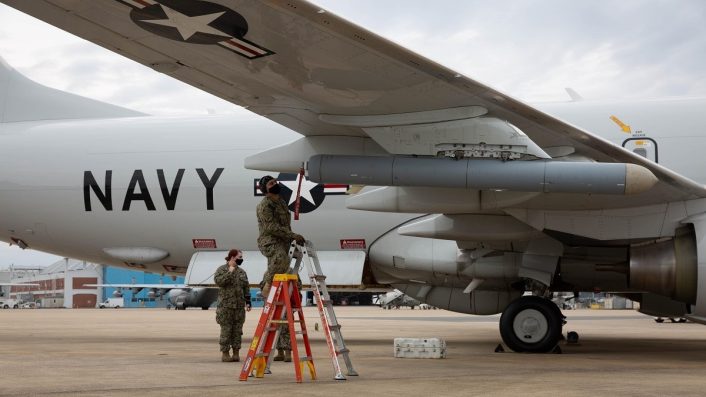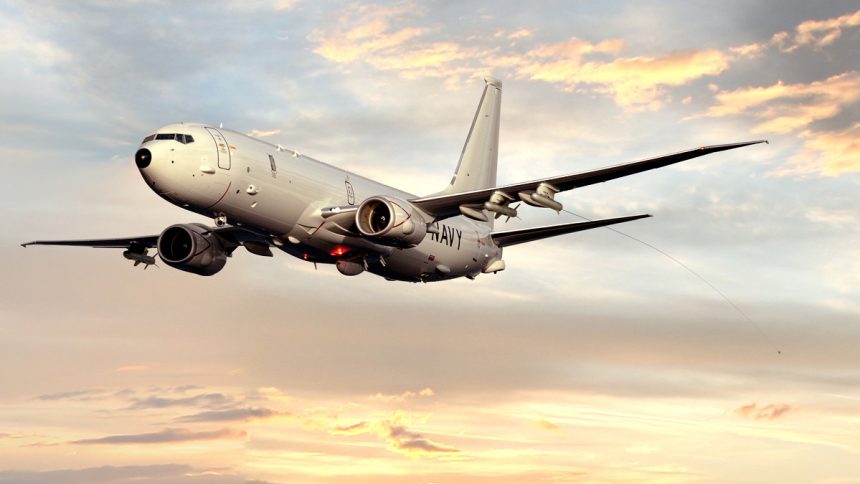The pod was first demonstrated in 2021 and employs the same ALE-55 Fiber-Optic Towed Decoy already used by the F/A-18E/F Super Hornet.
The U.S. Navy has awarded BAE Systems a $95 million contract to provide advanced countermeasure pods to protect the P-8A Poseidon Multi-Mission Maritime Aircraft from missiles and other threats. The new electronic warfare (EW) pod can detect and counter inbound radio-frequency threats, adding another layer of protection to the Poseidon.
“We’re working closely with the U.S. Navy to deliver innovative solutions to protect this critical, high-value aircraft,” said Don Davidson, director of Advanced Compact Electronic Warfare Solutions at BAE Systems. “We quickly prototyped a very capable system using proven technology to defend against air-to-air and surface-to-air guided threats.”
BAE Systems says the pod provides early threat detection and effective countermeasures, without providing other details. The only info released is that the pod is based on a flexible, open architecture design which allows rapid and affordable modernization, is compatible with future threat-detection and decoy countermeasure capabilities and can host third-party EW techniques.
The prototype
The company also mentions that the engineering and manufacturing development (EMD) contract follows a rapid-response contract from the U.S. Navy to demonstrate the system in 2021. In that occasion, the Navy and BAE Systems team designed, built, and tested a radio frequency countermeasure (RFCM) prototype pod, equipped with towed decoys. The rendering released for this contract is also the same used in 2021.
As we reported in that occasion, the basic concept behind the pod’s development was a quick and simple solution, as the shell designed for the pod is based on the AGM-84 Harpoon anti-ship missile already certified for employment with the P-8A Poseidon and for which plenty of data is available, reducing the length of the integration process.

The shell was then completed with the addition of the tracks and housing needed to fit and deploy the proven AN/ALE-55 Fiber Optic Towed Decoy, together with a small form factor jammer and a high-powered amplifier. This allowed a critical reduction of the amount of time and resources needed for this new self-protection technology to transition from prototype to fleet capability, bringing the pod into the testing phase in just over a year.
The ALE-55 Fiber-Optic Towed Decoy
The ALE-55 fiber-optic towed decoy is a highly advanced RF self-protection jammer that is already operational with the U.S. Navy F/A-18E/F Super Hornet and EA-18G Growler fleets and has been proven to be highly-effective against RF missile threats. The decoy is fully integrated with the ALQ-214 Integrated Defensive Electronic Countermeasures (IDECM) installed on the aircraft.
The ALE-55 towed decoy, as the name says, is a compact jammer towed by a fiber-optic cable which works together with the aircraft’s onboard Electronic Warfare (EW) system, jamming signals from incoming missiles with a high-powered response and guiding them safely away from the aircraft to the towed decoy. After the decoy is hit by the missile, the aircraft can then cut the towing cable and deploy another decoy if needed.
The ALE-55 was first fielded in 2010, employed as alternative to the ALE-50 “Little Buddy” Towed Decoy System used by older block configurations of IDECMS. Since then, BAE Systems has produced more than 3,000 ALE-55 decoys for customers around the world.









